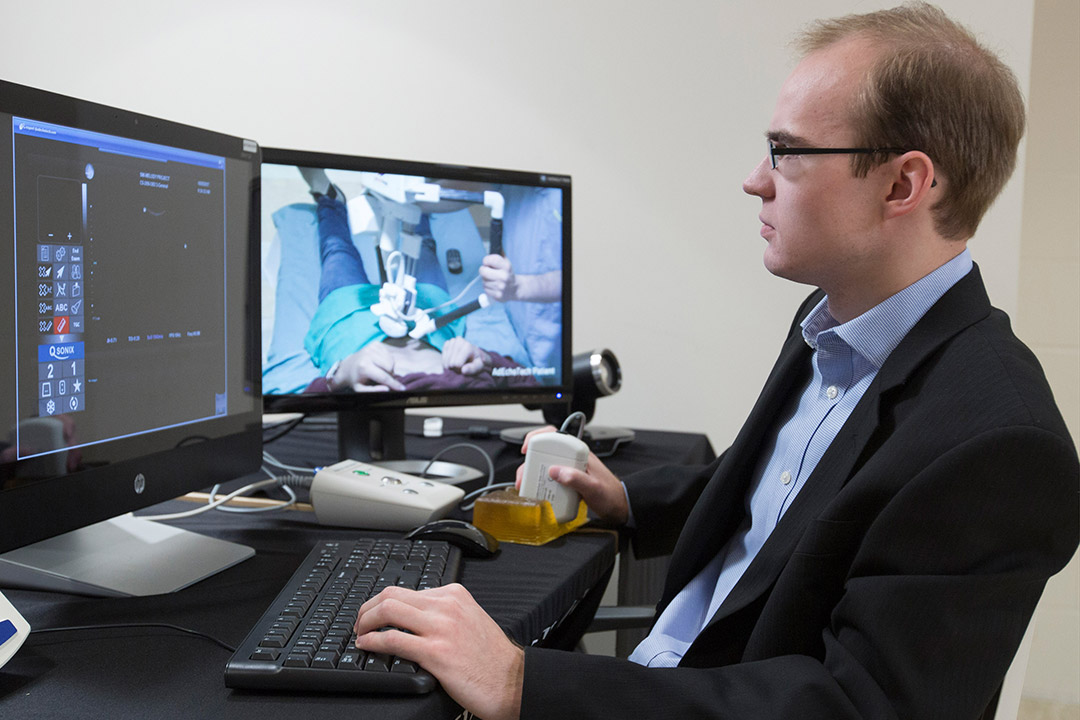
Remote imaging advances medical diagnoses
Patients in remote communities are a step closer to getting ultrasound imaging without having to travel long distances.
By Federica GiannelliUniversity of Saskatchewan researcher Scott Adams has proven that MELODY telerobotic sonography, a French-developed system that allows doctors to do long distance ultrasound imaging, is feasible for abdominal and prenatal imaging. Adams is part of the first research team to test this technology in North America.
“The new telerobotic system could help save time and money. Patients may get earlier diagnoses while reducing the strain on major referral hospitals,” said U of S medical imaging professor Paul Babyn, Adams’s supervisor along with surgery professor Ivar Mendez.
In two preliminary studies, one involving 18 patients and the other 30 pregnant women, Adams found that the telerobotic system is reliable for visualizing organs, and matches results and examination times obtained with conventional ultrasound.
Adams has published his results on the 18 patients in the Canadian Association of Radiologists Journal and recently presented his findings on prenatal imaging at an international radiology conference in the United States.
Bought with a $300,000 gift from the Leslie and Irene Dubé Foundation, the MELODY system consists of three parts: the ultrasound probe and robotic arm, placed in a community clinic, that can be manoeuvred on a patient’s body by an assistant with no prior experience using ultrasound; a control room at the U of S where radiologists or sonographers robotically control the probe and adjust the ultrasound settings; and video conferencing software.
“Saskatchewan is now a leading province in the application of remote technology in the country,” said Mendez. “People from across Canada have come to learn what we’re doing to develop models that could potentially be implemented in all jurisdictions.”
The new technology could make a difference for small towns and remote Indigenous communities in Saskatchewan. Without the need to transfer patients long distances for medical assessments, the healthcare system could save millions of dollars, said Adams, a U of S resident physician and health sciences graduate student.
“The new system was able to adequately visualize organs and abnormal findings. Abdominal and fetal measurements were similar to that obtained using conventional ultrasound,” said Adams.
With experience, the time to perform a telerobotic scan will be similar to a regular ultrasound, he said.
The cost of installing this technology is not higher than current high-end regular ultrasound units.
Because the preliminary results obtained in Saskatoon on the telerobotic system are promising, Adams, Babyn and Mendez are now assessing the system’s potential benefit to patients in remote communities.
The research team has moved the device to Stony Rapids, a Saskatchewan Indigenous community 80 kilometers south of the Northwest Territories border. This project is part of the Remote Presence Robotics Program for health care at the U of S and Northern Medical Services.
“Robotic ultrasound imaging is an ever-developing technology. We hope our studies will help develop an evidence base for scale-up and spread of this technology to improve patient care in Saskatchewan, Canada and beyond,” said Adams.
They expect the first results by the beginning of 2018.
Federica Giannelli is a graduate student intern in the U of S research profile and impact unit.
This article first ran as part of the 2017 Young Innovators series, an initiative of the U of S Research Profile and Impact office in partnership with the Saskatoon StarPhoenix.

